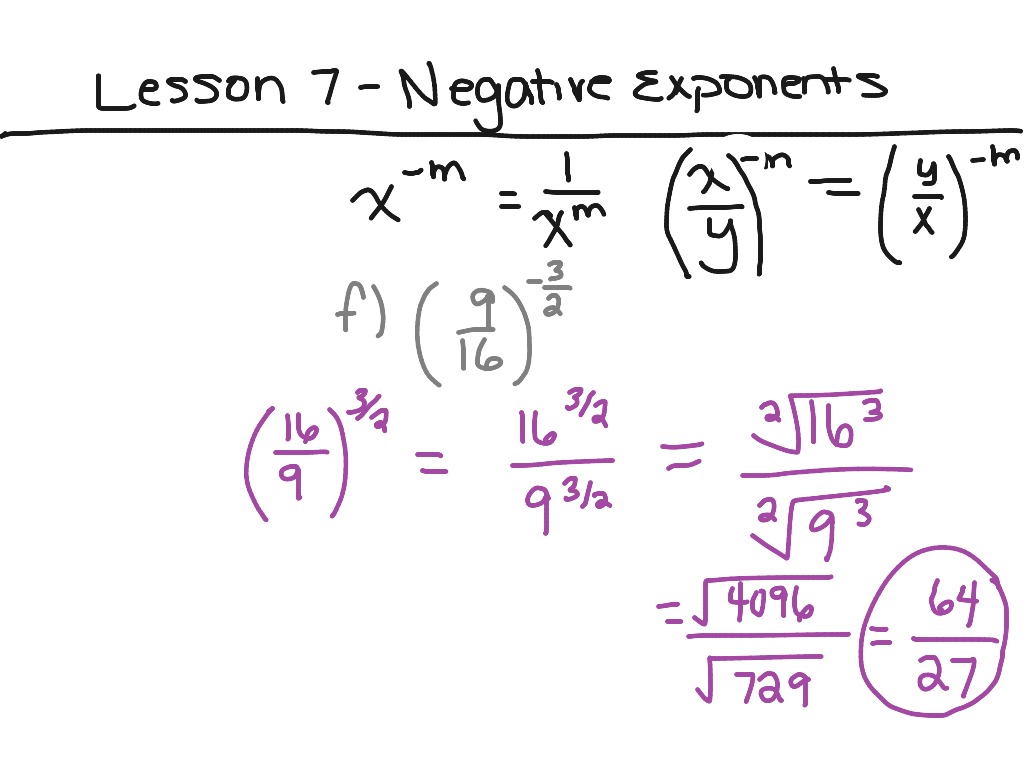
Ex3: Factor a Sum or Difference of Cubes.Ex1: Factor a Sum or Difference of Cubes.
FACTORING NEGATIVE EXPONENTS FOR FREE
License Terms: Download for free at Examples: Factoring Binomials (Special). What is 10 to the Negative Power of 2?ġ0 to the negative power of 2 is represented as 10 -2, which is equal to (1/10 2) = 1/100. So, the negative sign on an exponent indirectly means the reciprocal of the given number, in the same way as a positive exponent means the repeated multiplication of the base. When we need to change a negative exponent to a positive one, we are supposed to write the reciprocal of the given number. For example, y -5 × y -2 = 1/y 5 × 1/y 2 = 1/y (5+2) = 1/y 7 Why are Negative Exponents Reciprocals? Once they are converted to positive ones, we multiply them using the same rules that we apply for multiplying positive exponents. While multiplying negative exponents, first we need to convert them to positive exponents by writing the respective numbers in their reciprocal form. This makes it: y 5 × y 3 = y (5+3) = y 8. i.e., y 5 ÷ y -3 = y 5/y -3, first we change the negative exponent (y -3) to a positive one by writing its reciprocal. This can be simplified in an alternative way also. For example, to solve y 5 ÷ y -3 = y 5-(-3) = y 8.
FACTORING NEGATIVE EXPONENTS HOW TO
How to Divide Negative Exponents?ĭividing exponents with the same base results in the subtraction of exponents.

This results in 16/9 which is the final answer. Then, find the value of the number by taking the positive value of the given negative exponent. How to Solve Fractions with Negative Exponents?įractions with negative exponents can be solved by taking the reciprocal of the fraction.

There are two main rules that are helpful when dealing with negative exponents: For example, to solve: 3 -3 + 1/2 -4, first we change these to their reciprocal form: 1/3 3 + 2 4, then simplify 1/27 + 16. Negative exponents are calculated using the same laws of exponents that are used to solve positive exponents. For example, 2 -3 = 1/8, which is a positive number. No, it is not necessary that negative exponents give negative numbers. Do negative exponents Result in Negative Numbers? For example, in the number 2 -8, -8 is the negative exponent of base 2. The negative exponents mean the negative numbers that are present in place of exponents.

Rewrite the expression using the negative exponent rule bn 1 bn b - n 1 b n. 1/4 -2 + 1/2 -3 = 4 2 + 2 3 =16 + 8 = 24 Algebra Polynomials and Factoring Multiplication of Polynomials by.Use the second rule with a negative exponent in the denominator: 1/a -n =a n.Take the Least Common Multiple (LCM): (9 + 4)/36 = 13/36.Because all numbers are 2-to-a-power, youll be factoring out common multiples. Here you can choose to factor out the biggest 'number' by sight,, or the number thats technically greatest. Use the negative exponent rule a -n = 1/a n Factoring negative exponents may feel a bit different from the more traditional factoring that you do more frequently, but the mechanics are the same.Let us apply these rules and see how they work with numbers. Rule 2: The rule is the same even when there is a negative exponent in the denominator.



 0 kommentar(er)
0 kommentar(er)
